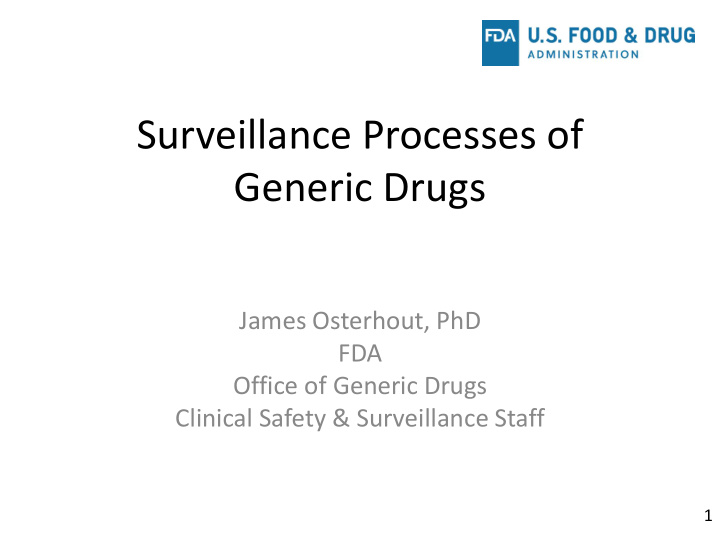



Surveillance Processes of Generic Drugs James Osterhout, PhD FDA Office of Generic Drugs Clinical Safety & Surveillance Staff 1
Potential Safety Signal • Contacts from the public directly to FDA • MedWatch reports submitted to FDA • Identified in CDER’s Office of Generic Drugs (OGD) and Office of Surveillance and Epidemiology (OSE) databases • Sponsor reports • Scientific Literature • OGD definition of a potential signal may be different from that of OSE • Generic drug complaints (inequivalence) differ from rare adverse events related to the active pharmaceutical ingredient 2 2
Scope of Generic Surveillance • Generic surveillance does NOT focus on complaints related to the active ingredient • Generic surveillance DOES involve: – Therapeutic inequivalence – Problems with quality - odor, taste, rapid oral disintegration – Problems with packaging - dropper, cap – Novel or more prevalent AEs as compared to the reference listed drug (RLD) product • These problems may be related to allowed differences between the RLD and the generic 3 3
Databases • Drug Quality Reporting System (DQRS) • FDA Adverse Event Reporting System (FAERS) • Marketplace Data - IMS, Symphony – Limitations of Spontaneous Reporting • Many reports do not identify a specific generic product • Many complaints for generics are misattributed to the RLD product 4 4
Drug Quality Reporting System • A subset of MedWatch reports that contain complaints related to quality or inequivalence are entered into DQRS. • These reports may also contain adverse events (AEs) and thus the same reports would also be in FAERS. • Largely spontaneous reports - enriched in cases of product inequivalence and quality problems • Approximately 600 MedWatch reports per month • Searchable for multiple fields with dynamic reporting 5 5
101B DQRS Report • Main report used is the 101B that was designed by OGD staff to accommodate the periodic surveillance reports 6 6
DQRS • Search results are exported into Excel for sorting and analysis for any potential signals • The report output contains manufacturer and lot if available, defect and a full narrative from the reporter. • A custom SAS program written by CSSS is used to analyze the complaints and identify and potential signals. • Individual narratives are reviewed to identify any single report that may need further review by a medical officer. 7 7
Marketing Data • Two sources of marketing (distribution) data are used – IMS Smart • National Sales Perspective (NSP) • National Prescription Audit (NPA) – Symphony • Drug distribution data is considered when investigating a potential signal in an attempt to compare multiple generic manufacturers by calculating a relative rate. 8 8
Retrospective and Prospective Generic Surveillance 1 • Retrospective - Monthly Surveillance Report – Short-term emerging signals – Safety Evaluator reviews 1 month of DQRS complaints to identify any single report warranting further scrutiny by safety team – Reports sorted by manufacturer/product to identify clusters for a single manufacturer indicating a possible emerging problem – Any problems or potential signals identified are forwarded for discussion at the Monthly CSSS Committee Meeting. 9 9
Retrospective and Prospective Generic Surveillance 2 • Prospective – “Newly Approved” Generic Watch List – Anticipates future Signals – Each surveillance period, the Safety Evaluator reviews the list and searches for complaints on new generics – DQRS complaints in initial weeks of marketing are documented – New generics that meet signal criteria are added to the New Generic Watch List and monitored over time. • Weber Effect? 10 10
Detailed Review of Individual Potential Safety Issues 1 • Safety Evaluator performs an in-depth evaluation for a safety, quality, or inequivalence signal: • Search of FDA databases: DQRS (quality) and FAERS (AEs): – Additional observations related to the problem – Background rate of same observations for RLD • Review of ANDA and RLD Information • Market Share Determination-IMS Sales Data • Scientific / Medical literature research 11 11
Detailed Review of Individual Potential Safety Issues 2 • Components & Composition, Release Mechanism, Excipients • CMC changes, recent manufacturing changes • Review of BE data for possible areas of concern • Relevant FARs (Field Alert Reports) for the product 12 12
Real Life Example: Metoprolol ER Tablet • CDER received a letter in December 2012 from prominent cardiologist • Described episodes of therapeutic failure for generic products from several manufacturers • Occurred when patient switched from RLD or Authorized Generic (AG) to generic product • Samples of the RLD and generic product were obtained and tested by the FDA Office of Testing and Research • Differences in the reporting of adverse events between the RLD and the generics was assessed by CDER (OGD, OSE) • A Tracked Safety Issue was opened by OGD and a safety investigation team was formed • TSI Result - Based on the review of available data the FDA safety investigation team determined all products should remain acceptable for substitution to the RLD (AB) 13 13
Real Life Example: Clonidine Patch • Clonidine Transdermal System (0.1, 0.2 or 0.3 mg per day) – Indicated in the treatment of hypertension • OGD identified 89 reports for this new to market generic product, largely involving lack of adhesion and efficacy • MedWatch report narratives complained of the large size of the generic patch as compared to the RLD For 0.3 mg/day: generic = 32.4 cm 2 and RLD = 10.5 cm 2 – • FDA inspected generic company in December 2009 and serious problems were identified in the manufacture of the clonidine patches • A warning letter was issued to generic on May 21, 2010. • Subsequently, generic company voluntarily removed the product from the market 14 14
Acknowledgements • Clinical Safety & Surveillance Staff – Howard Chazin, MD : Director – Linda Forsyth, MD : Medical Officer – Debbie Catterson, RPh : Safety Coordinator – Jung Lee, MS : Safety Officer 15 15
Recommend
More recommend